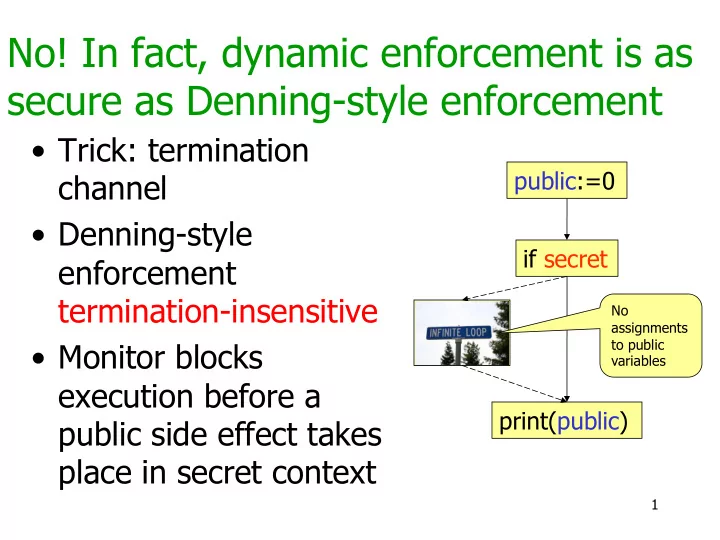

No! In fact, dynamic enforcement is as secure as Denning-style enforcement • Trick: termination public:=0 channel • Denning-style if secret enforcement termination-insensitive No assignments to public • Monitor blocks variables execution before a print(public) public side effect takes place in secret context 1
Modular enforcement Actions # Program Monitor b cfg ⟶ " cfg’ cfgm ⟶ " cfgm’ s skip a(x,e) x:=e b(e) ; f if…, while… 2
Termination-insensitive monitor stack of • cfgm=st security contexts • prevent explicit flows l:=h • prevent implicit flows if h then l:=0 – by dynamic pc = highest level on context stack Action Monitor’s reaction stop if stack update a(x,e) x and (e or pc) b(e) push(lev(e)) f pop 3
Security and relative permissiveness • Denning-style analysis enforces termination-insensitive security – for while language [Volpano, Smith & Irvine’96] – for language with I/O [Askarov, Hunt, Sabelfeld & Sands’08] • Monitoring enforces termination- insensitive security – for while language – for language with I/O • Monitoring more permissive than static analysis – Typable programs not blocked by monitor – l:=l*l; if l<0 then l:=h 4
Flow sensitivity • Flow-insensitive analyses in this talk so far secret := 0; if secret then public := 1 • Rejected by flow-insensitive analysis • Flow sensitive analysis relabels secret when it is assigned public constant – E.g. [Hunt & Sands’06] • Particularly useful for low-level languages – secure register reuse 5
Not all channels can be collapsed into termination channel • Can we generalize Secure the results to flow- sensitive case? Preserved by monitor • Intuition: even more dynamism with flow- sensitivity so we Typed should gain in precision 6
Flow sensitivity: Turns out • Can have sound or permissive analysis Preserved but not both Typed by monitor • Theorem: no purely dynamic Secure permissive and sound monitor 7
Trade off between permissiveness and soundness public := 1; temp := 0; if secret then temp := 1; if temp != 1 then public := 0 • Purely dynamic monitor needs to make a decision about temp • Impossible to make a correct decision without sacrificing permissiveness 8
Proof I public := 1; temp := 0; • If secret is true, if secret then temp := 1; we can type: if temp != 1 then public := 0 skip; output(public) • By permissiveness, it should be accepted by monitor • By dynamism, original program also accepted by monitor public := 1; temp := 0; if secret then temp := 1; if temp != 1 then public := 0; output(public) 9
Proof II public := 1; temp := 0; • If secret is false, if secret then temp := 1 skip; we can type: if temp != 1 then public := 0; output(public) • By permissiveness, it should be accepted by the monitor • By dynamism, original program also accepted by monitor public := 1; temp := 0; if secret then temp := 1; if temp != 1 then public := 0; output(public) • => Insecure program always accepted by monitor • Can have sound or permissive purely dynamic monitor but not both 10
Static vs. dynamic • Fundamental trade offs between dynamic and static analyses Secure Secure Preserved Preserved Preserved by by Typed monitor by monitor monitor Secure Typed Typed Flow-insensitive Flow-sensitive analysis Flow-sensitive analysis analysis, hybrid monitors • Case studies to determine practical consequences 11
Recommend
More recommend